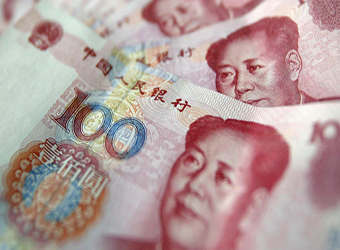China’s yuan overtook the euro to become the second-most used currency in global trade finance in 2013, according to the Society for Worldwide Interbank Financial Telecommunication.
The currency had an 8.66 percent share of letters of credit and collections in October, compared with 6.64 percent for the euro, Swift said in a statement today. China, Hong Kong, Singapore, Germany and Australia were the top users of yuan in trade finance, according to the Belgium-based financial-messaging platform. The yuan’s share of global trade finance was 1.89 percent in January 2012, while the euro’s was 7.87 percent, Swift said.
“The renminbi is clearly a top currency for trade finance globally and even more so in Asia,” Franck de Praetere, Swift’s Singapore-based head of payments and trade markets for Asia Pacific, said in the statement.
China is seeking a greater role for its currency in global trade and investment as the state loosens controls on the exchange rate and borrowing costs in the world’s second-largest economy. People’s Bank of China Deputy Governor Yi Gang said Nov. 20 it is no longer in the nation’s interest to keep building up its foreign-exchange reserves, which totaled a record $3.66 trillion at the end of September.
Yuan deposits in Hong Kong, the largest pool outside China, rose the most since April 2011 to a record 782 billion yuan ($128 billion) in October. Agreements were announced this quarter to start direct currency trading between the yuan and both the British pound and Singapore dollar.
Global Payments
The Chinese currency ranked No. 12 for transactions in the global payments system in October, unchanged from the previous month, according to Swift figures. Payment value for the currency rose 1.5 percent that month, less than the 4.6 percent growth for all currencies, the Swift data showed. That saw the yuan’s market share drop to 0.84 percent from 0.86 percent in September.
Daily yuan transactions surged to $120 billion in April from $34 billion in 2010, making it the ninth most-traded currency in the world, according to a September report by the Bank for International Settlements in Basel, Switzerland.
The yuan has appreciated 2.3 percent against the greenback this year, the best performance in Asia, according to data compiled by Bloomberg. The currency was little changed at 6.0926 per dollar today in Shanghai.
Yuan Trade
International use of the yuan is increasing as China opens up its capital markets. In the first nine months of this year, about 17 percent of China’s global trade was settled in the currency, compared with less than 1 percent in 2009, according to Deutsche Bank AG.
China and the U.K. will begin direct trading between the yuan and the British pound, Chancellor of the Exchequer George Osborne said on Oct. 15. China also approved an 80 billion yuan quota allowing investors in London to buy onshore assets. Singapore inked a similar agreement with China a week later. Direct trading between the currencies of Japan and Australia started in the past two years.
The European Central Bank and the People’s Bank of China agreed to establish a bilateral currency swap line of as much as 350 billion yuan, the Frankfurt-based central bank said in October.
The Chinese central bank limits the yuan spot rate’s daily moves to 1 percent on either side of a fixing it sets every day. The trading band was widened in April 2012, after being expanded from 0.3 percent in May 2007. The yuan in Shanghai has traded 0.7 percent stronger than the fixing on average this quarter, down from 0.8 percent in the first nine months of the year, according to data compiled by Bloomberg.
The People’s Bank of China will “basically” end normal intervention in the foreign-exchange market and broaden the yuan’s daily trading limit, Governor Zhou Xiaochuan wrote in an article in a guidebook explaining reforms outlined following a Communist Party meeting that ended Nov. 12.
Source: Bloomberg



